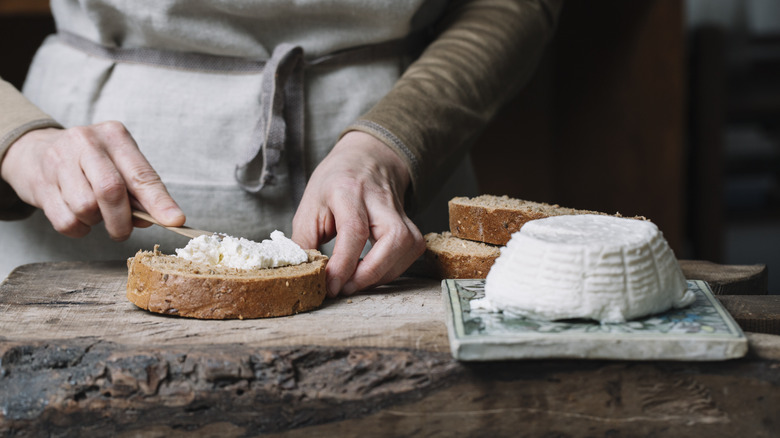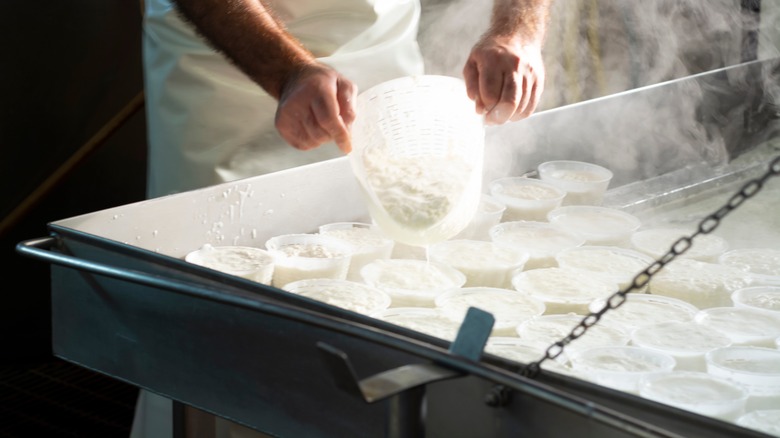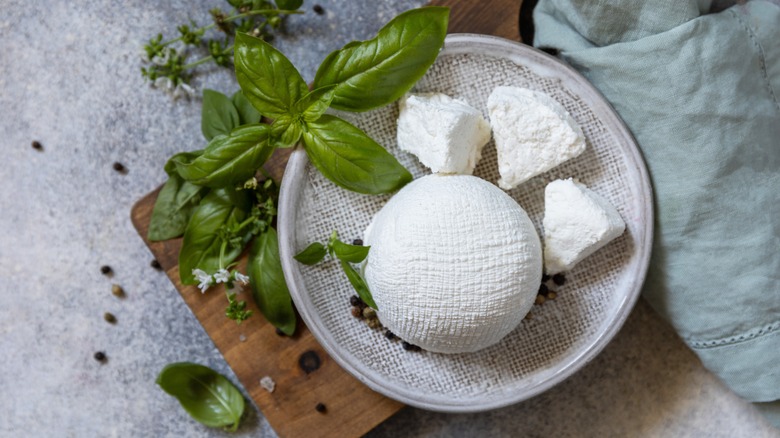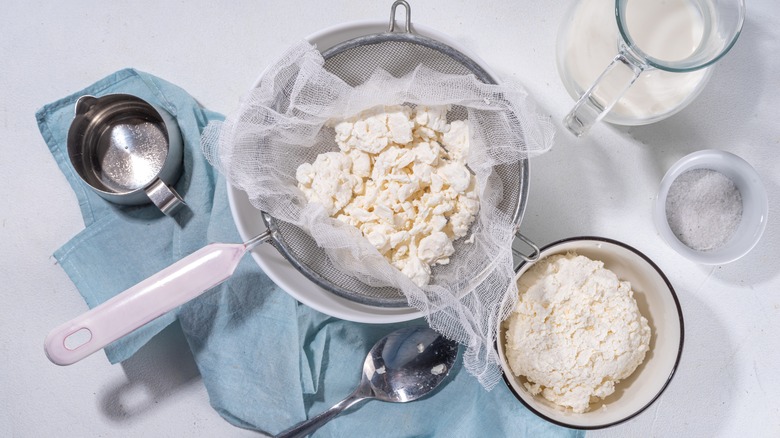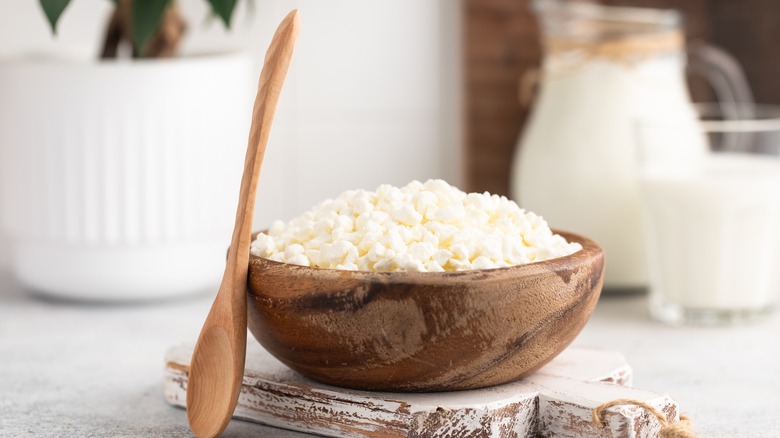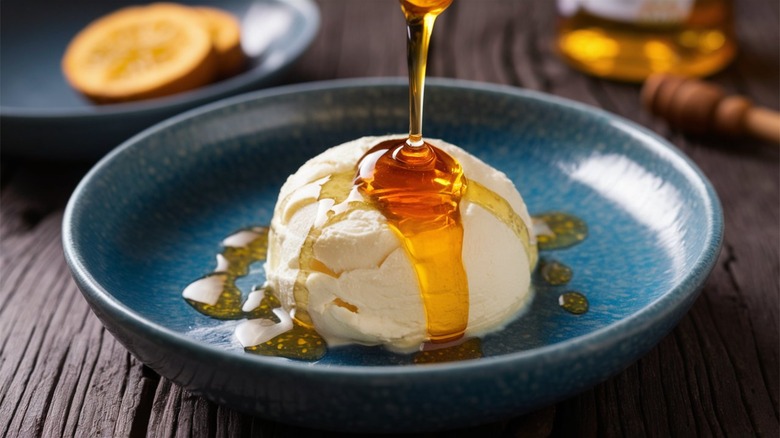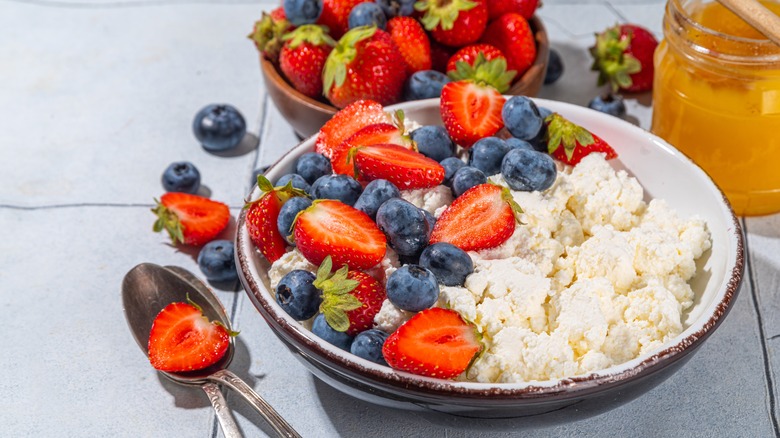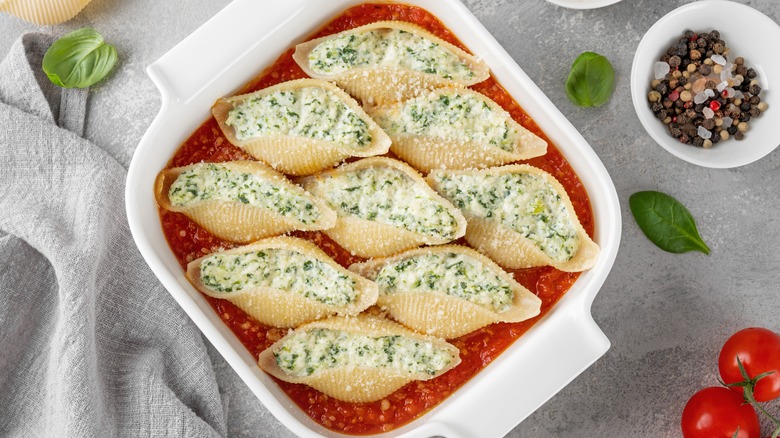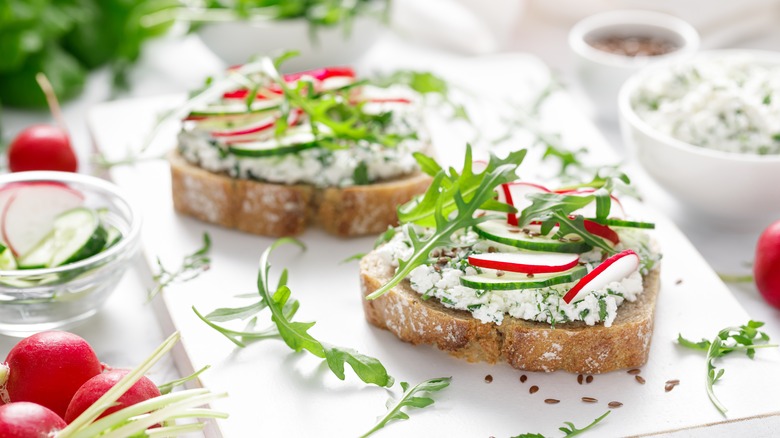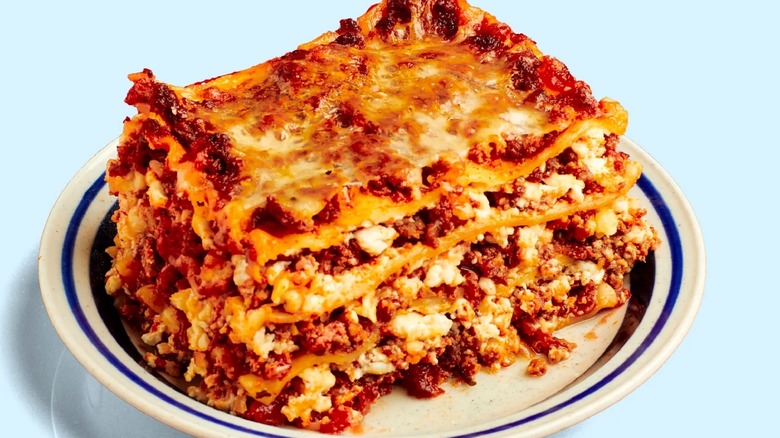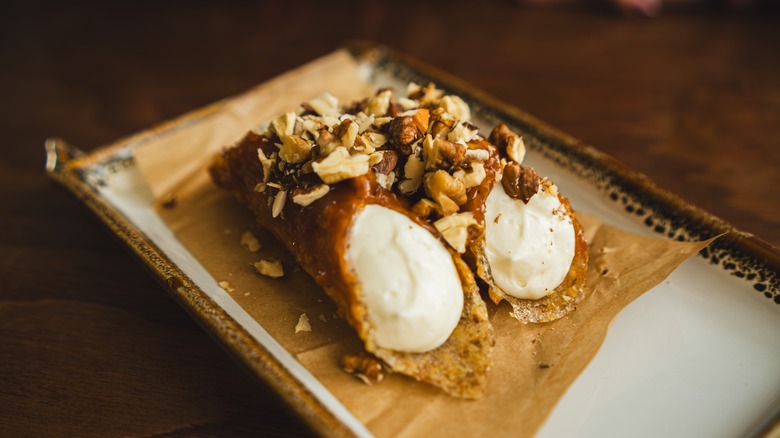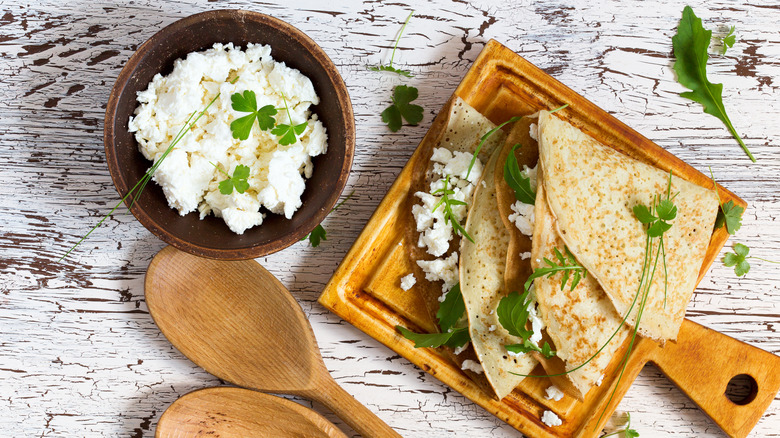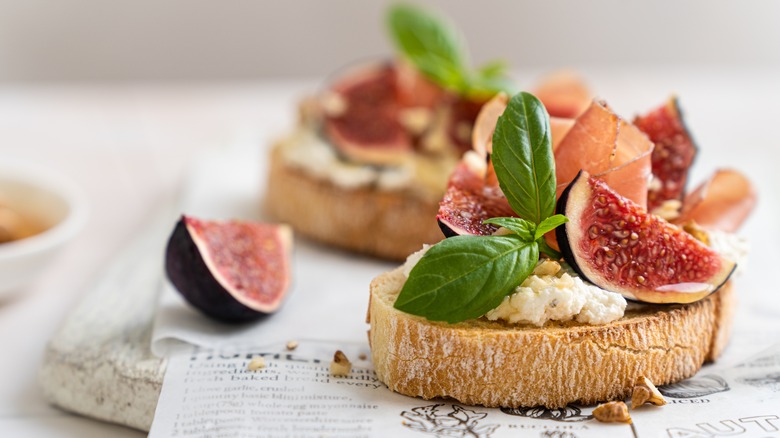Ricotta Vs Cottage Cheese: How They Are Different And Which One To Choose
In the world of fresh cheeses, ricotta and cottage cheese are two of the most popular options. Both are white with soft, spoonable consistencies and seemingly have a lot in common. That might leave you wondering about the difference between cottage cheese and ricotta cheese and which one you should choose.
There's no clear cut better or worse cheese between the two, they're just different options. So, it pays to learn enough about them both that you can pick the right one for the task at hand. For instance, if you're looking to make stuffed pasta, ricotta is the obvious choice, whereas cottage cheese might be better for topping bread or crackers when it's time for a snack. Ultimately, like any ingredient, each has particular uses.
We spoke to four experts, including chefs and a former cheesemaker, to find out everything there is to know about these cheeses. This helped us discover the primary differences between ricotta and cottage cheese, as well as the ways in which they're similar, and we're about to share the wealth. You'll never again have to wonder which one to use.
Both cottage cheese and ricotta are made in similar ways
Cheesemaking can be a complex process, but both ricotta and cottage cheese are made in a simple way. The process for making them is distinct, though relatively similar compared to other types of cheese. We spoke to Shannon Berry, Certified Cheese Professional at Wisconsin Cheese to learn more about how each is made.
Berry explains that ricotta is made from the residual whey from cheesemaking. "Italians first crafted ricotta to make use of Romano cheese's leftover whey," she says. "They cooked the whey until the curds rose, then skimmed and drained them, and voila: ricotta!" That's where this cheese gets its name, as ricotta means "recooked" in Italian.
On the other hand, cottage cheese, Berry explains, gets its name because it was often made in farmhouses or cottages. "Cottage cheese is made using starter cultures and rennet, which is how many cheeses, like mozzarella or cheddar, begin," she tells us. A more solid curd forms than it does for ricotta and this is cut, giving cottage cheese its distinctive texture, explaining why you can get it in different curd sizes.
Cottage cheese is made using cow's milk, as is most commercially available ricotta, but this actually isn't traditional. Ricotta "is traditionally made with residual sheep's milk leftover from the production of pecorino cheese," notes Jessica Sennett, an experienced cheesemaker, a cheesemonger, and creator of Cheese Grotto. Ricotta can also be made with other milk, including buffalo milk and goat milk.
Ricotta and cottage cheese are both fresh and unaged
"Ricotta and cottage cheese are both fresh, unripened cheeses," says cheese expert Shannon Berry. Olivia Roszkowski, chef-instructor at the Institute of Culinary Education in New York also explains to us that these cheeses are fresh and unaged. But what does this mean and how does it impact the texture and flavor?
Most cheeses, from cheddar to camembert, are aged. This process is also known as ripening and involves letting the cheese sit (in a temperature- humidity-controlled environment) for anywhere from weeks to years. During this time, good bacteria, molds, and fungi develop, giving individual cheese varieties their distinctive tastes and textures. It's a vital part of the process for a lot of cheese varieties.
Fresh cheeses, however, don't need to be aged. They can be eaten — or packaged, ready to sell, right after being made. Because the sharp, intense flavors of cheese come primarily from the ripening process, fresh cheeses are much milder. This explains why cottage and ricotta cheese taste the way they do.
You can make both cottage cheese and ricotta yourself at home
Because of how simple cottage cheese and ricotta are to produce, you can make them both yourself at home. Well, technically speaking, you can make any cheese from scratch, but you'd need a controlled environment to age it in and a lot of patience. These fresh cheeses you can whip up quickly and eat right away. Even if you've never considered yourself the cheesemaking type, you'll be surprised how easy it is.
"Ricotta can be made from scratch by bringing a combination of whole milk and cream to just below a simmer and adding an acid such as lemon juice to create curds," culinary arts instructor Olivia Roszkowski tells us. She explains that you then place the mixture in a cheesecloth and let it drain over a strainer for up to a few hours. And that's it — you have ricotta. It can be more expensive to make than it is to buy, but for some people, it's all about the fun of crafting it from scratch.
"Making cottage cheese is a similar process to making ricotta cheese, but requires a bit more acid and squeezing the curds after they sit in cheesecloth," says Roszkowski. "Cottage cheese can also be made by adding a specific bacterial culture that will eat some of the natural lactose sugar in the milk and produce lactic acid. This acid will work to then separate the whey and the milk solids to produce cottage cheese."
Cottage cheese has a lumpy texture
If you've eaten cottage cheese before, you've probably noticed its distinctive texture. "It has a slightly lumpy texture due to the curds and whey separation process, giving it a more substantial mouthfeel compared to ricotta," remarks Chef Gigi Gaggero, former academic director of Le Cordon Bleu culinary school.
Ricotta has a much smoother, creamier texture that cheesemaker and Cheese Grotto founder Jessica Sennett describes as "delicate" and "pillowy." She tells us, "Ricotta is very fluffy, its curd structure is tiny granules that are so delicate it is creamy and spreadable and like a pillowy cloud." Cottage cheese is another matter. Sennett explains it has a more defined shape to its curd structure because of the curd cutting process. "Though still creamy and nowhere near as firm as a Wisconsin cheese curd in density, those curds provide a completely different mouthfeel and have a more lasting definition," she adds.
In short, cottage cheese is lumpy while ricotta is smooth and creamy. One isn't necessarily better than the other, it just depends on what you're looking for. Sometimes you want the texture that cottage cheese brings to a dish, while other times you want something light and smooth. It varies on a case-by-case basis.
Ricotta is sweeter and less tangy than cottage cheese
There are plenty of nutritional reasons why you should be eating ricotta, but the biggest reason is that it tastes amazing. "Ricotta has a cooked curd or cooked milk flavor," says cheese specialist Jessica Sennett. "It is sweeter due to the quick set transformation of milk into pillowy, amorphous curds floating in the liquid whey. The higher temperatures in which ricotta is set result in this flavor profile." So, you can expect a sweet, rich, and mild flavor from ricotta cheese.
Cottage cheese also tastes good, just different. While it isn't as sharp as aged cheeses, it isn't quite as mild as ricotta. "Cottage cheese is much more lactic and tangy due to its long culturing process and dressing in milk or cream," Sennett tells us.
Which you should reach for depends on the kind of flavor profile you want from a dish. "Ricotta cheese pairs nicely with fresh produce like figs, broccoli, eggplant, fennel, garlic, kale, leeks, berries, mushrooms, oranges, spinach, and peas," chef and cooking school teacher Olivia Roszkowski notes. The tangy notes of cottage cheese are contrasted by sweet, fresh ingredients, which is why it's so often paired with fruit.
Cottage cheese is higher in protein and lower in fat than ricotta
Cottage cheese is known for being low in fat, which is neither here nor there when it comes to nutrition. Fat is actually an important part of our diets, so specifically looking for low-fat foods isn't necessarily good for you, but it's fine if you make sure to eat other healthy fats, such as nuts, avocado, and olive oil. Fat aside, cottage cheese is surprisingly nutritious, in part because of its high protein content.
"A typical cup of cottage cheese is over 70% protein and can contain up to 28 grams of protein," Institute of Culinary Education chef-instructor Olivia Roszkowski tells us. On the other hand, "a typical cup of ricotta cheese is made up to about two-thirds fat and about a quarter protein content," Roszkowski adds. This means ricotta has significantly more fat and less protein than cottage cheese.
If you eat a balanced diet, you don't need to worry too much about the exact quantities of protein and fat you're consuming. In fact, if you eat meat, you're more likely to be eating too much protein than not enough. However, in some cases it can be useful to keep an eye on your protein and fat intake, whether you need to increase it or decrease it, so it's good to know what each of these cheeses offer.
Ricotta cheese is commonly used in Italian food
Ricotta is an Italian cheese, so you'll often find it in the nation's cuisine. It's in everything from Italian desserts and baked goods, like cannoli and cakes, to pasta dishes, such as spinach and ricotta cannelloni, to this creamy lemon-ricotta pasta recipe. But, of course, it isn't only used in Italian cooking; there are many ways to cook with this fresh cheese.
"Ricotta is great whipped and used as a crostini topping with honey and pine nuts, and as a filling for ravioli or puff pastry with jam," says Olivia Roszkowski. She also likes it as a stuffing for zucchini blossoms, in pound cake, in cannoli filling, or used to make a cheesecake.
According to cheesemaker Jessica Sennett, it's "incredible when mixed into pancake batter for fluffy Lemon Ricotta pancakes." She remarks that "ricotta adds a fluffy, creamy body wherever it is used: from baked lasagna, to pizza with broccoli rabe, to ricotta gnocchi where potatoes are replaced with ricotta and 00 flour." You don't have to go wild with elaborate recipes, either. "Personally, I like ricotta on toast, savory with pesto, or sweet with jam," certified cheese professional Shannon Berry tells us. Sennett agrees that high-quality ricotta makes a nice breakfast spread on toast with honey.
Cottage cheese is generally eaten as a snack or a dip
Chef Gigi Gaggero tells us that cottage cheese is "often used in salads, dips, and as a topping for toast or crackers." It has a reputation as a health food that's eaten as a low-fat snack, but it's so much more versatile than people give it credit for. If you like to snack on plain cottage cheese, that's great, but there's no reason why you can't get more creative and branch out.
"Cottage cheese can be blended into batters or paired with fresh fruit like cantaloupe or pineapple. When cottage cheese is blended, it can be used to create fluffy egg bites or a frittata, salad dressings, or even act as a component in pizza crust," notes Chef Olivia Roszkowski. There are some recipes that use cottage cheese as a secret ingredient — you'd never guess it was in there.
But it's fine to like the basics, too, where this cheese is involved. "Cottage cheese is the classic high protein breakfast cheese with fresh fruit or spread on toast," says Jessica Sennett. "Good quality cottage cheese doesn't need much except flakey salt and freshly cracked pepper." Shannon Berry is also a fan of eating it for breakfast. "I like it mixed in my oatmeal, or I'll start with cottage cheese and add fruit, honey, and granola."
Full-fat cottage cheese is similar enough to ricotta to use as a sub
You might be wondering whether you can switch out ricotta for cottage cheese if that's what you have on hand. The answer is usually yes, but with some provisos. If the recipe you're making calls for full-fat ricotta, then fat-free cottage cheese won't cut it. And if you need a smooth texture, you'll have to blend it.
"Full-fat, small curd cottage cheese can resemble the taste of ricotta cheese," culinary instructor Olivia Roszkowski explains. She notes that cottage cheese can be used as a swap for ricotta. "For instance, try swapping cottage cheese for ricotta in your next lasagna, homemade gnocchi or pancake recipe," she adds.
If cottage cheese is what you've got on hand, why not experiment and see what happens? "I recently made a lasagna and I had some cottage cheese in the cooler I needed to use," Gigi Gaggero tells us. "I was surprised with the delicious outcome. The flavor cottage cheese provided to the lasagna 100% had to do with rich saltness, and of course the tang of the acid. I think I stumbled on a new recipe!" The same goes the other way around. You can replace the cottage cheese in a recipe with ricotta, as long as the chunky curds aren't a key component.
Ricotta and cottage cheese can both be used in sweet recipes
Both ricotta and cottage cheese are versatile enough that you can use them in sweet recipes, as well as savory ones. Ricotta shines in desserts thanks to its smooth texture and sweet notes. It's a key ingredient in classic Italian pastries like cannoli. This cheese also elevates cheesecakes, making them lighter and fluffier than cream cheese versions. You could also try blending it with honey and fruits to create a topping for pancakes or a filling for crêpes.
Cottage cheese is also great in sweet recipes. You can blend it until smooth and use it as a base for cheesecakes or puddings. It pairs well with fruits such as peaches, strawberries, or pineapple, so you can blitz it with something sweet and use it in a parfait. It can also be sweetened with a touch of honey or maple syrup and served as a creamy topping for waffles or pancakes.
You can add both cheeses to baked goods, as well. Incorporating ricotta or cottage cheese into muffin or pancake batters helps give you a tender crumb. You also get some complex tanginess in the mix. Of course, if you use cottage cheese, you'll need to blend it first.
Cottage cheese is having a resurgence in popularity
After a surge in popularity as a diet food in the '80s and '90s, cottage cheese became pretty unpopular. It was seen as bland and boring, but things have started to change. Over the last few years, there's been a cottage cheese resurgence and it seems to be thanks to TikTok.
"We've seen a growing number of cottage cheese trends leaning into the versatility of the product," says Shannon Berry of Wisconsin Cheese. "According to Google, as of June 12, 2024, the hashtag #cottagecheese on TikTok had over 550 million views. It's safe to say cottage cheese is seeing a resurgence in everyday use."
"The image of cottage cheese is definitely on the up and up," cheese expert Jessica Sennett agrees. "TikTok seems to have rediscovered it recently as a delicious and simple breakfast, but as TikTok normally does, it has gone much further than that, incorporating cottage cheese into cookies, dips, and cheesecakes," she adds. Sennett notes that people on TikTok still have somewhat of a visceral reaction to the texture of cottage cheese, but this contributes to its growing popularity — "a food item that everyone was thinking was 'gross' or uncool turns out to be an amazing, delicious option." TikTokers enjoy being surprised that they actually like cottage cheese.
Should you choose ricotta or cottage cheese?
Now you know more about both of these cheeses, you might be trying to decide which you should buy. The fact is, there's no simple answer. It isn't just black and white. Whether you should choose ricotta or cottage cheese depends on your preferences and what you'll be using it for. If you're looking for a cheese with a sweet, mild taste, ricotta is the obvious choice, whereas cottage cheese is better for those who want more of a tang. Want a smooth, pillowy texture? Pick up some ricotta? Prefer some lumps from cheese curds? Cottage cheese is what you want.
Because of its high protein content, cottage cheese is a good choice for a filling breakfast, while ricotta is richer and nicer if you want something more decadent. You can use both of these cheeses for cooking. Ricotta is the more obvious choice for Italian dishes and desserts, but you can use either in these roles. Cottage cheese just needs to be blended and will bring more tanginess to the dish. So, ultimately, there's no right or wrong here, it's just about what you want from your cheese.
